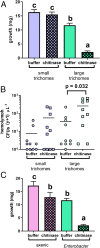Plant defenses interact with insect enteric bacteria by initiating a leaky gut syndrome
- PMID: 31332013
- PMCID: PMC6689943
- DOI: 10.1073/pnas.1908748116
Plant defenses interact with insect enteric bacteria by initiating a leaky gut syndrome
Abstract
Plants produce suites of defenses that can collectively deter and reduce herbivory. Many defenses target the insect digestive system, with some altering the protective peritrophic matrix (PM) and causing increased permeability. The PM is responsible for multiple digestive functions, including reducing infections from potential pathogenic microbes. In our study, we developed axenic and gnotobiotic methods for fall armyworm (Spodoptera frugiperda) and tested how particular members present in the gut community influence interactions with plant defenses that can alter PM permeability. We observed interactions between gut bacteria with plant resistance. Axenic insects grew more but displayed lower immune-based responses compared with those possessing Enterococcus, Klebsiella, and Enterobacter isolates from field-collected larvae. While gut bacteria reduced performance of larvae fed on plants, none of the isolates produced mortality when injected directly into the hemocoel. Our results strongly suggest that plant physical and chemical defenses not only act directly upon the insect, but also have some interplay with the herbivore's microbiome. Combined direct and indirect, microbe-mediated assaults by maize defenses on the fall armyworm on the insect digestive and immune system reduced growth and elevated mortality in these insects. These results imply that plant-insect interactions should be considered in the context of potential mediation by the insect gut microbiome.
Keywords: Lepidoptera; chitinase; maize; microbiome; trichome.
Copyright © 2019 the Author(s). Published by PNAS.
Conflict of interest statement
The authors declare no conflict of interest.
Figures



Similar articles
-
Concerted impacts of antiherbivore defenses and opportunistic Serratia pathogens on the fall armyworm (Spodoptera frugiperda).Oecologia. 2022 Jan;198(1):167-178. doi: 10.1007/s00442-021-05072-w. Epub 2021 Nov 6. Oecologia. 2022. PMID: 34741665
-
Turnabout Is Fair Play: Herbivory-Induced Plant Chitinases Excreted in Fall Armyworm Frass Suppress Herbivore Defenses in Maize.Plant Physiol. 2016 May;171(1):694-706. doi: 10.1104/pp.15.01854. Epub 2016 Mar 15. Plant Physiol. 2016. PMID: 26979328 Free PMC article.
-
Fall Armyworm-Associated Gut Bacteria Modulate Plant Defense Responses.Mol Plant Microbe Interact. 2017 Feb;30(2):127-137. doi: 10.1094/MPMI-11-16-0240-R. Epub 2017 Feb 16. Mol Plant Microbe Interact. 2017. PMID: 28027025
-
Maize Endochitinase Expression in Response to Fall Armyworm Herbivory.J Chem Ecol. 2021 Jul;47(7):689-706. doi: 10.1007/s10886-021-01284-9. Epub 2021 May 31. J Chem Ecol. 2021. PMID: 34056671
-
Complex Relationships at the Intersection of Insect Gut Microbiomes and Plant Defenses.J Chem Ecol. 2020 Aug;46(8):793-807. doi: 10.1007/s10886-020-01187-1. Epub 2020 Jun 15. J Chem Ecol. 2020. PMID: 32537721 Review.
Cited by
-
Tomato Chemical Defenses Intensify Corn Earworm (Helicoverpa zea) Mortality from Opportunistic Bacterial Pathogens.J Chem Ecol. 2023 Jun;49(5-6):313-324. doi: 10.1007/s10886-023-01420-7. Epub 2023 Mar 25. J Chem Ecol. 2023. PMID: 36964896
-
The Gut Microbiota Composition of Cnaphalocrocis medinalis and Their Predicted Contribution to Larval Nutrition.Front Microbiol. 2022 May 20;13:909863. doi: 10.3389/fmicb.2022.909863. eCollection 2022. Front Microbiol. 2022. PMID: 35668757 Free PMC article.
-
Complex plant quality-microbiota-population interactions modulate the response of a specialist herbivore to the defence of its host plant.Funct Ecol. 2022 Nov;36(11):2873-2888. doi: 10.1111/1365-2435.14177. Epub 2022 Sep 15. Funct Ecol. 2022. PMID: 36632135 Free PMC article.
-
Host Species Determines the Composition of the Prokaryotic Microbiota in Phlebotomus Sandflies.Pathogens. 2020 May 29;9(6):428. doi: 10.3390/pathogens9060428. Pathogens. 2020. PMID: 32485988 Free PMC article.
-
Concerted impacts of antiherbivore defenses and opportunistic Serratia pathogens on the fall armyworm (Spodoptera frugiperda).Oecologia. 2022 Jan;198(1):167-178. doi: 10.1007/s00442-021-05072-w. Epub 2021 Nov 6. Oecologia. 2022. PMID: 34741665
References
-
- Agrawal A. A., Fishbein M., Plant defense syndromes. Ecology 87 (suppl. 7), S132–S149 (2006). - PubMed
-
- Rasmann S., Agrawal A. A., Plant defense against herbivory: Progress in identifying synergism, redundancy, and antagonism between resistance traits. Curr. Opin. Plant Biol. 12, 473–478 (2009). - PubMed
-
- Hay M. E., Kappel Q. E., Fenical W., Synergisms in plant defenses against herbivores—Interactions of chemistry, calcification, and plant-quality. Ecology 75, 1714–1726 (1994).
-
- Mithöfer A., Boland W., Plant defense against herbivores: Chemical aspects. Annu. Rev. Plant Biol. 63, 431–450 (2012). - PubMed
-
- Schuman M. C., Baldwin I. T., The layers of plant responses to insect herbivores. Annu. Rev. Entomol. 61, 373–394 (2016). - PubMed
Publication types
MeSH terms
Substances
Associated data
LinkOut - more resources
Full Text Sources
Other Literature Sources

